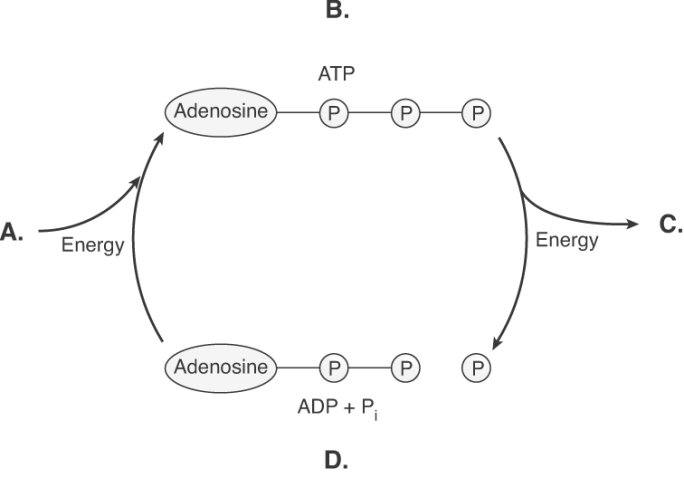A) protein is synthesized.
B) amino acids are buffered in the kidney.
C) the amine group is removed from an amino acid.
D) fatty acids are broken down to yield acetyl CoA.
E) glutamic acid is produced.
G) None of the above
Correct Answer

verified
Correct Answer
verified
Multiple Choice
Slim N. Trim has been on a low-fat, no carbohydrate diet for two months. Which of the following would you expect to find in large quantities in the urine?
A) glucose
B) lactic acid
C) pyruvic acid
D) ketone bodies
E) proteins
G) None of the above
Correct Answer

verified
Correct Answer
verified
Multiple Choice
The formation of triglycerides is called
A) glycogenesis.
B) lipogenesis.
C) gluconeogenesis.
D) ketogenesis.
E) beta-oxidation.
G) A) and B)
Correct Answer

verified
Correct Answer
verified
Short Answer
The chemical formation of ATP is coupled to a diffusion force in __________.
Correct Answer

verified
Correct Answer
verified
Multiple Choice
About 95% of the lipids in the human diet are
A) cholesterol derivatives.
B) lecithins.
C) triglycerides.
D) starches and other complex polysaccharides.
E) phospholipids.
G) A) and B)
Correct Answer

verified
Correct Answer
verified
Multiple Choice
Which of the following is the correct sequence?
A) acetyl-CoA formation, glycolysis, electron-transport chain, citric acid cycle
B) acetyl-CoA formation, citric acid cycle, electron transport chain, glycolysis
C) citric acid cycle, glycolysis, acetyl-CoA formation, electron transport chain
D) glycolysis, acetyl-CoA formation, citric acid cycle, electron transport chain
E) glycolysis, citric acid cycle, acetyl-CoA formation, electron transport chain
G) A) and C)
Correct Answer

verified
Correct Answer
verified
Multiple Choice
Match the vitamin with its associated disease. -niacin
A) scurvy
B) night blindness
C) beriberi
D) pellagra
E) pernicious anemia
G) B) and E)
Correct Answer

verified
Correct Answer
verified
Multiple Choice
Which of the following will increase metabolic rate?
A) exercise
B) fasting
C) malnutrition
D) reduced caloric intake
E) dieting
G) None of the above
Correct Answer

verified
Correct Answer
verified
Multiple Choice
Match the function or term with the appropriate organic molecule. -vitamins A, E, D, K
A) carbohydrates
B) lipids
C) proteins
D) nucleic acids
F) A) and C)
Correct Answer

verified
Correct Answer
verified
Multiple Choice
The events that occur in the postabsorptive state collectively
A) decrease fat metabolism.
B) maintain blood glucose levels.
C) interconvert proteins to fats.
D) assure adequate lipogenesis.
E) maintain protein levels.
G) A) and B)
Correct Answer

verified
Correct Answer
verified
Multiple Choice
Match the function or term with the appropriate organic molecule. -primary energy source
A) carbohydrates
B) lipids
C) proteins
D) nucleic acids
F) All of the above
Correct Answer

verified
Correct Answer
verified
Multiple Choice
What type of reactions are involved in ATP production?
A) single replacement reactions
B) combustion reactions
C) oxidation-reduction reactions
D) neutralization reactions
F) A) and B)
Correct Answer

verified
Correct Answer
verified
Multiple Choice
Which of the following vitamins is mismatched with its function?
A) vitamin D - bone growth
B) vitamin A - rhodopsin synthesis
C) folate - synthesis of clotting factors
D) vitamin C - collagen synthesis
E) vitamin B12 - red blood cell production
G) C) and D)
Correct Answer

verified
Correct Answer
verified
Multiple Choice
Transamination
A) results in free fatty acids.
B) requires glucose.
C) can be used to synthesize essential amino acids.
D) involves removing an amine group from an amino acid.
E) directly produces urea.
G) B) and C)
Correct Answer

verified
Correct Answer
verified
Multiple Choice
Which of the following is/are possible uses of amino acids in energy production?
A) forming a ketoacid that can enter the citric acid cycle
B) forming intermediate molecules of carbohydrate metabolism
C) forming NADH that enters the electron-transport chain.
D) All of the choices are uses of amino acids in energy production.
F) A) and C)
Correct Answer

verified
Correct Answer
verified
Multiple Choice
Use the following key to choose the best answer. -(1) heat loss wearing a hat; (2) heat loss without a hat
A) Choose A if the first item is greater than the second item.
B) Choose B if the first item is less than the second item.
C) Choose C if the first item is equal or nearly equal to the second item.
E) A) and C)
Correct Answer

verified
Correct Answer
verified
Multiple Choice
 -The diagram illustrates ATP coupling of catabolic and anabolic reactions. What does "A" represent?
-The diagram illustrates ATP coupling of catabolic and anabolic reactions. What does "A" represent?
A) ATP breakdown
B) anabolism
C) catabolism
D) ATP production
F) A) and D)
Correct Answer

verified
Correct Answer
verified
Multiple Choice
One gram of carbohydrate, one gram of lipid, and one gram of protein yield ____, ____, and ____ kilocalories respectively.
A) 4, 4, 4
B) 9, 9, 9
C) 4, 9, 4
D) 4, 9, 9
E) 9, 9, 4
G) A) and E)
Correct Answer

verified
Correct Answer
verified
Multiple Choice
Which of the following are energy nutrients?
A) carbohydrates, proteins, and lipids
B) proteins, water, and minerals
C) lipids, minerals, and vitamins
D) vitamins, lipids, and carbohydrates
E) water, minerals, and vitamins
G) A) and C)
Correct Answer

verified
Correct Answer
verified
Multiple Choice
Which of the following recommendations regarding daily requirements is correct?
A) Fats should account for 45% of total caloric intake.
B) Carbohydrate intake should be around 500 grams daily.
C) Protein consumption should be 10-35% of total kilocalorie intake.
D) Cholesterol intake should be about 300 milligrams per day.
E) Protein consumption should be about 45% of total kilocalorie intake.
G) A) and B)
Correct Answer

verified
Correct Answer
verified
Showing 121 - 140 of 164
Related Exams